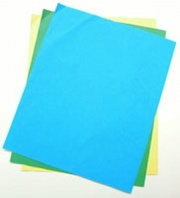Carbon paper
Jump to navigation
Jump to search
Description
A thin paper coated on one side with a dense pigment in a waxy binder. First patented about 1810, carbon paper is used to make duplicates. The Carbon black, or Lampblack, pigment was held in place with a wax or oil-soluble binder. Carbon paper is placed between two blank sheets of paper with the pigment facing the lower page. Mechanical marks made with a pen, pencil, or typewriter, on the top page will be replicated on the bottom page with pigment from the carbon paper. Unglazed paper, called carbon copy paper, was often used for the bottom, or copy, page for better acceptance of the transfer.
Synonyms and Related Terms
carbonizing paper; carbon tissue; papier carbone (Fr.); papier carboné (Fr.); transfer paper; graphite paper
Resources and Citations
- Boise Cascade Paper Group, The Paper Handbook, Boise Cascade, Portland OR, 1989
- Matt Roberts, Don Etherington, Bookbinding and the Conservation of Books: a Dictionary of Descriptive Terminology, U.S. Government Printing Office, Washington DC, 1982
- The Dictionary of Paper, American Paper Institute, New York, Fourth Edition, 1980
- E.J.LaBarre, Dictionary and Encyclopedia of Paper and Paper-making, Swets & Zeitlinger, Amsterdam, 1969
- Edward Reich, Carlton J. Siegler, Consumer Goods: How to Know and Use Them, American Book Company, New York City, 1937
- G.S.Brady, Materials Handbook, McGraw-Hill Book Co., New York, 1971 Comment: p. 145
- Random House, Webster's Encyclopedic Unabridged Dictionary of the English Language, Grammercy Book, New York, 1997
- The American Heritage Dictionary or Encarta, via Microsoft Bookshelf 98, Microsoft Corp., 1998
- Art and Architecture Thesaurus Online, http://www.getty.edu/research/tools/vocabulary/aat/, J. Paul Getty Trust, Los Angeles, 2000
